I received a lot of mail regarding my selection of .25-06 Remington and .257 Weatherby cartridges, almost all from semi-courteous supporters of the various .257 Roberts’ cartridges, each writer reminding me of the +P version’s potential, and the long successful service the standard round has provided. My thought is that I don’t like “retro” cartridges and if Roberts wanted to have his cartridge appear in this article, he should have made it right the first time, rather than wait for some lame overstuffed +P version to come along. I’m kidding, but this is probably a good point to get out from under all of this.
There are many cartridges that can come within 10% to 25% of either of the cartridges I selected in delivering down range velocity, trajectory and energy. The original notion was not that the two selected cartridges were the fastest available, or the most well balanced cartridges, but rather they could fill the gap between the small 6mm’s and the 7mm magnums. I would have like to have tried the .257-284, or the .257 STW; unfortunately time, money, retention of sanity, coupled with my own assessment of performance potential took me in the chosen direction. Hopefully, there will be enough general information buried in here to be useful to other .257″ bore cartridge reloaders.
Bullet Selection
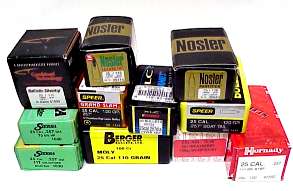 I’ve handloaded for some cartridges where bullet selection was limited to two or three primary weights, and bullet form was either round nose or spitzer; the .257″ bore does not fall into the category. I would only caution that this multitude of bullets was designed to cover many types of .25 caliber cartridges.
I’ve handloaded for some cartridges where bullet selection was limited to two or three primary weights, and bullet form was either round nose or spitzer; the .257″ bore does not fall into the category. I would only caution that this multitude of bullets was designed to cover many types of .25 caliber cartridges.
Numerous low performance .25 caliber cartridges are now obsolete, but the bullets designed for these cartridges are still being produced, and these lightly constructed, poorly streamlined examples are not acceptable for use with the .25-06 Remington or .257 Weatherby Magnum. As an example, some time ago I was experimenting with a 60 grain flat point Hornady slug that is probably appropriate for the .25-20 and .25-35 Winchester, but absolutely inappropriate for the .25-06 or .257 Weatherby. After some time at the bench, I wasn’t able to find many remnants of these bullets, on a 36″ target, 50′ from the muzzle. Clearly these were not intended to be shot from a rifle at 4000+ fps, through a barrel with a 1-10″ twist.
In addition to this extreme example, I believe there is some bullet construction that may be more appropriate for .250 Savage, or original .257 Roberts levels of velocity. A swing of 400 to 600 fps of muzzle velocity makes for a significant difference in bullet jacket requirements, particularly when considering shorter contact ranges. A bullet designed for the .250 Savage may work for the Weatherby if contact with game is made at 300 yards, but the same bullet would come apart quickly inside of a 100 yards where velocity exceeds the design criteria.
I tried to select bullet types and manufacture I have used in high velocity applications with success, if not in the .257″ bore, than perhaps in a .284″ or .338″, but still at muzzle velocities above 3200 fps. The table below lists my original selections and covers the items in the table photo from left to right.
|
|
|||||
| Manufacturer | Product | Core | Grains | B C | Unit Cost $* |
| Speer | Grand Slam | 1 piece | 120 | 0.328 | .37 |
| Speer | Boat Tail | 1 piece | 120 | 0.435 | .38 |
| Nosler | Partition | 2 piece | 120 | 0.391 | .42 |
| Sierra | Game King | 1 piece | 117 | 0.410 | .18 |
| Hornady | InterLock | 1 piece | 117 | 0.391 | .18 |
| Comb. Tech. | Ballistic ST | 1 piece | 115 | 0.453 | .28 |
| Nosler | Ballistic Tip | 1 piece | 115 | 0.453 | .24 |
| Berger | Moly | 1 piece | 110* | 0.414 | .30 |
| Barnes | XLC | solid copper | 100 | 0.401 | .60 |
| GS Custom | HV | solid copper | 100 | 0.400 | .80* |
| Sierra | Varminter | 1 piece | 75 | 0.189 | .14 |
| *Unit cost based on Midway USA current pricing and GS Custom direct purchase – includes delivery | |||||
Next, I researched each manufacturer’s site for further information and reduced the project list to what I felt would be the best hunting bullets. I thought it might be useful to list the final reasons for selection or omission, so I left the table in it’s original form and highlighted the project survivors.
 Speer Grand Slam – Grand slam bullets begin life as a simple cup, drawn into a closed base cylinder to begin formation of a jacket of relatively heavy construction. A rear lead core is added, then material is sheared from the forward portion of the jacket cylinder, and forced down over the lead core as a locking ring. The rear core protrudes through the center of this ring, so when the forward portion of molten core (Hot-Cor technology) is added, the two core sections are fused together.
Speer Grand Slam – Grand slam bullets begin life as a simple cup, drawn into a closed base cylinder to begin formation of a jacket of relatively heavy construction. A rear lead core is added, then material is sheared from the forward portion of the jacket cylinder, and forced down over the lead core as a locking ring. The rear core protrudes through the center of this ring, so when the forward portion of molten core (Hot-Cor technology) is added, the two core sections are fused together.
As I understand it, Speer’s intention is to use molten lead, to eliminate cold forming the core which would require lubrication. The ring is to lock the core in place within the jacket, and the lack of lubrication is to assist in the same objective. In bore sizes above .257″, Speer utilizes a hard lead alloy in the rear core and a softer alloy in the forward core for even better control of expansion. I believe Speer figured out how to get Nosler Partition like bullet performance, from a less costly process.
I know they hold together quite well in my .338-378. The only down side I would note is a less than ideal BC, probably as a result of the flat protected soft point configuration. Is this significant in the overall performance of the bullet ? By comparison, Speer’s Boat Tail with better aerodynamics would drop 1″ less, retain 200+ fps more velocity and hit with 250 ft/lbs more energy at 300 yards. Maybe the optimal range is inside 300 yards, or maybe the bullet’s construction is so superior, the 10% loss in performance is an equitable tradeoff ?
Speer Boat Tail – The boat tail does not use Hot-Cor technology, and is a simple one piece core design. Speer notes these are more fragile in construction than Hot-Cor bullets and do not penetrate as deeply. I couldn’t see an offsetting benefit, so these were dropped from the project list. The text offered by Speer on Boat Tail bullets was a little confusing; on one hand they made it clear Boat Tail bullets are more accurate and drop less than conventional flat based bullets at all ranges and velocities, then on the other they suggested the differences may not be significant enough to warrant using a Boat Tail Bullet.
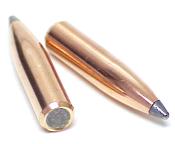 Nosler Partition – Nosler Partitions are high quality A or frame type bullets. Isolated rear and forward jacket compartments hold the two piece core and provide excellent penetration and controlled expansion. I have used Partitions in just about every rifle I own, and they are the basis for many of my favorite hunting handloads. Partitions are middle of the road in BC, and they are comparatively expensive. Some bore sizes and weights are available in a dry lube coated form through the Combined Technology partnership between Nosler and Winchester..
Nosler Partition – Nosler Partitions are high quality A or frame type bullets. Isolated rear and forward jacket compartments hold the two piece core and provide excellent penetration and controlled expansion. I have used Partitions in just about every rifle I own, and they are the basis for many of my favorite hunting handloads. Partitions are middle of the road in BC, and they are comparatively expensive. Some bore sizes and weights are available in a dry lube coated form through the Combined Technology partnership between Nosler and Winchester..
Sierra Game King – I dropped this Sierra product. I like Sierra bullets; they are inexpensive, very accurate in use and perform admirably even though they are a bullet of simple construction. I know Sierra varies core alloy hardness based on bullet diameter and intended use, and they seem to have nailed this down quite well, but I wanted something with tougher jacket construction for the .257 Weatherby and I thought the Hornady bullet offered better bullet construction at the same price. The Sierra bullet has slightly better BC.
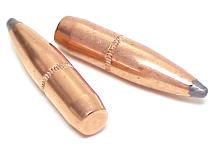 Hornady InterLock – I was going to drop this bullet from the project list, only because I felt it was redundant to the Speer Grand Slam. The Hornady is another bullet that uses an internal ring to lock the bullet’s core to the jacket. I have used these bullet in a wide variety of cartridges with good success, with the primary advantage over the Grand Slam being cost, and the exposed soft point that yields a better BC.
Hornady InterLock – I was going to drop this bullet from the project list, only because I felt it was redundant to the Speer Grand Slam. The Hornady is another bullet that uses an internal ring to lock the bullet’s core to the jacket. I have used these bullet in a wide variety of cartridges with good success, with the primary advantage over the Grand Slam being cost, and the exposed soft point that yields a better BC.
Combined Technology Ballistic Sliver Tip and Nosler Ballistic Tip – I elected to drop both of these. The CT Silver Tip is basically the Nosler Ballistic Tip with a Lubalox® coating. These are of a one piece core design and have relatively fragile jackets. The Nosler Reloading Guide Number 4 does not list this bullet in this weight for the .25-06 or the .257 Weatherby for hunting applications.
Berger Standard Moly – This bullet was dropped. Berger does offer 27 selections for the .257″ bore from 72 to 120 grains, but these are primarily for competition target shooting and varmint hunting. They are an excellent product; highly uniform from one box to the next and very accurate in virtually every bore size offered, however their use is outside of the scope of this project.
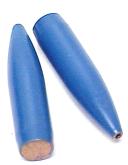 Barnes XLC – I’ve grown more and more appreciative over time of Barnes solid copper bullets. The newest XLC additions seem to be an improvement on an already successful theme. While there is a 115 grain Barnes X with a better BC, I’ve had very good luck with lighter than maximum bullet weights with Barnes, and I wanted more time to work with their dry film coated product.
Barnes XLC – I’ve grown more and more appreciative over time of Barnes solid copper bullets. The newest XLC additions seem to be an improvement on an already successful theme. While there is a 115 grain Barnes X with a better BC, I’ve had very good luck with lighter than maximum bullet weights with Barnes, and I wanted more time to work with their dry film coated product.
My experience with these bullets now has been .224″, .338″, .375″ and .416″; each has performed admirably. The only problem I’ve encountered is a bit of diameter variance within a lot, but I believe this is in the coating and has not had a negative effect on uniformity of performance.
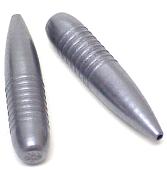 GS Custom HV – This is an experiment for me, as I have no prior experience with this product. On the surface they look a little like BarnesX meets cast bullet form and the back end of a pre 1960 Ferrari. The bullet utilizes driving bands to reduce bore friction, has a very long ogive and is of solid construction. The producer claims the bullets will generate higher velocity than traditional bullets at the same chamber pressures. I should at least be able to qualify comparative accuracy and velocity. I have some recommendations regarding powder charges from the folks at GS, so we’ll try them and see what happens.
GS Custom HV – This is an experiment for me, as I have no prior experience with this product. On the surface they look a little like BarnesX meets cast bullet form and the back end of a pre 1960 Ferrari. The bullet utilizes driving bands to reduce bore friction, has a very long ogive and is of solid construction. The producer claims the bullets will generate higher velocity than traditional bullets at the same chamber pressures. I should at least be able to qualify comparative accuracy and velocity. I have some recommendations regarding powder charges from the folks at GS, so we’ll try them and see what happens.
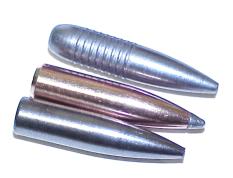 I thought I’d include a photo comparison between the HV moly (top) and the Nosler Partition and Berger Moly bullets – the difference is quite dramatic.
I thought I’d include a photo comparison between the HV moly (top) and the Nosler Partition and Berger Moly bullets – the difference is quite dramatic.
Looking at the GS under magnification, there are quite a few radial tool marks. The driving bands are raised substantially above the bullet shank, and rounded trailing edges usually aren’t the most aerodynamic in reducing drag, so perhaps all of these elements combine for the result of a modest ballistic coefficient for such as long tapering bullet.
Sierra Varminter – This bullet was dropped. As tempting as it was to see how fast I could get these things to go, the effort probably had little application to the subject at hand. In addition, I thought I would have to introduce another type of powder to properly utilize this light bullet.
Powder Selection

Based on previous experience, and after reviewing a lot of load data, I elected to go with: AlliantRL25, RL19, IMR 7828 and Hodgdon H1000, as pictured left to right above. In slowest burn rate order it would be: RL25, H1000, IMR7828, and RL19. I’ve been working toward measuring some of the real world effects of temperature and humidity change on powder charges so I had some of these images set aside. RL25 had the longest granules and greatest variance in length. RL19 was shorter, but more uniform, IMR7828 was smaller in diameter than RL25 and very uniform in length, H1000 was the shortest length and also very uniform in size. Burn rate is determined by the physical size of the powder granules, but also by burn retardant coating the powder.

Two powders recommended frequently, that I passed on, were Hodgdon H870 (L) and Winchester 760. Unlike stick or extruded powders noted above, these are both spherical or Ball type powders. For me they have yielded excellent velocity, but less than exciting accuracy.
Some of these powders are relatively new and some are quite old. RL19 and H1000 have been on the market for approximately 13 years, RL25 for approximately 2 years. IMR7828 has been around for just about 40 years, Win 760 has been with us for 33 years. H870, developed for the 20mm Vulcan cannon became available to handloaders in 1959. As you can see, propellants are a very dynamic and state of the art component of handloading.
I particularly like Alliant product which always seems to reach high velocity, with lower pressures and with good accuracy. IMR7828 is probably as good in accuracy and velocity, especially with lighter bullets in large capacity cases. Reloder 19 and IMR7828 should be a benefit with the slightly smaller .25-06 case and lighter bullets. I have high hopes that, one day, Alliant will change its product name from Reloder to Reloader so people outside of this area of interest won’t be left with the impression that gun people can’t spell.
Miscellaneous
I’ll be assembling ammo with new Remington and Weatherby brass, .25-06 and .257 Weatherby respectively, and I will be using CCI primers. I’ll also take this opportunity to check out a new power case trimmer and an RCBS Turret press. All of the components used in this article were purchased from Midway USA and Lock, Stock & Barrel as a retail customer.
More “Quarter Inch Solutions”
Quarter Inch Solutions Part I
Quarter Inch Solutions Part II
Quarter Inch Solution III – Handload Development
Handload Data 25-06 Remington
Handload Data 257 Weatherby Magnum
Thanks,
Joe

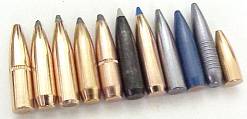
Email Notification